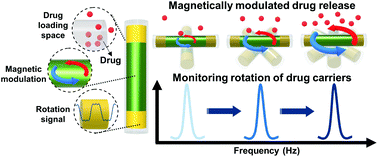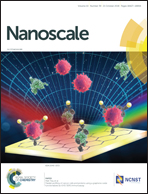Multi-block magnetic nanorods for controlled drug release modulated by Fourier transform surface plasmon resonance†
Abstract
Stimuli-responsive tunable drug release using nanocarriers is an important subject in smart drug delivery systems. Specifically, magnetic-responsive nanocarriers provide a great opportunity for remote control as well as on-demand command. To effectively utilize magnetic-responsive nanocarriers in vivo and in vitro, drug release should not only be controlled in an efficient way, but also monitored in situ. To satisfy those prerequisites, a template-assisted electrochemical deposition method can be a great option for the synthesis of designer materials that are targeted for specific purposes. Here, we synthesized plasmonic–magnetic nanocarriers by template-assisted electrochemical deposition and covered their surface with a silica shell for drug loading. By appropriately designing the blocks, we synthesized nanocarriers that were plasmonically active and magnetically active with spaces for drug payload. These nanocarriers could be modulated under an external magnetic field and their rotation (or agitation) could be monitored by Fourier transform conversion. Using our nanocarriers, we systematically investigated the tunable release of the anticancer drug doxorubicin as a function of the external magnetic field. Additionally, by applying this modulation system to an in vitro system using HeLa cells we were able to not only monitor the modulation systems but also tailor the drug release in a controlled manner. We expect that our approach will contribute to understanding of nanocarriers in a simulative manner in vitro.



 Please wait while we load your content...
Please wait while we load your content...